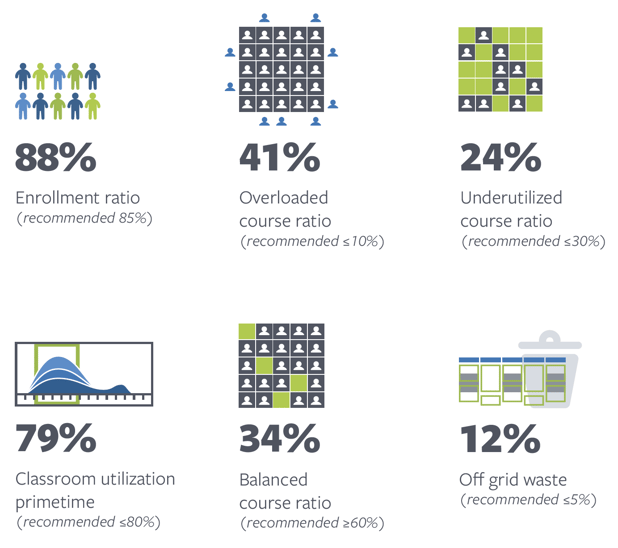Definition: The percentage of unique courses offered that are balanced with student need, defined as having an enrollment ratio between 70% and 95%
Service: Strategic Scheduling

Increasing Graduation Rates and Meeting Graduation Initiative 2025 Through Strategic Scheduling
When students can't enroll in the classes they need to graduate, changes must be made to ensure timely completions. California State University is a great example of a university making large strides to encourage timely graduations. Continue reading to learn where the California State University system began, changes that are being implemented, and their impact on students due to these scheduling changes.

In 2016, the California State University (CSU) system launched Graduation Initiative 2025 to “increase graduation rates, eliminate equity gaps in degree completion, and meet California’s workforce needs.” A core element of this strategy centers on improving course capacity and meeting high student demand for core classes. To take advantage of the opportunity, CSU institutions partnered with Ad Astra to assist with improving course access and, ultimately, graduation rates. Redefining paths to graduation allowed CSU partners to identify bottlenecks and allocate resources, which helped lead to immediate improvements in retention and graduation rates. Additionally, the California State University Office of the Chancellor recognized that students infrequently get the courses they need to progress in their academic journey, and that investing in additional course sections can remove barriers to student success. To help with this, Ad Astra has partnered with 11 CSU institutions to support Graduation Initiative 2025 by strategically identifying and adding the courses that students need most to graduate on time.

When we began working with the CSU system, we identified a few areas of improvement by analyzing some key metrics. If you are interested in learning more about these metrics, check out our key terms.

Definition: The percentage of unique courses offered that are balanced with student need, defined as having an enrollment ratio between 70% and 95%
Service: Strategic Scheduling
Definition: The percentage of hours in the primetime subset of a standard week (as defined by each institution’s usage patterns) that a typical classroom is in use
Software: Astra Schedule
Service: Strategic Scheduling, Meeting Pattern Analysis
Definition: The rate at which students complete their degree
Software: Predict, Align, Monitor
Service: Cohort Enrollment Health
Definition: The percentage of capacity wasted by scheduling non-standard meeting patterns during primetime hours
Software: Astra Schedule
Services: Strategic Scheduling, Meeting Pattern Analysis
Definition: The percentage of unique courses offered that are difficult for students to register for because they have a high enrollment ratio, defined as having an enrollment ratio of 95% or higher
Service: Strategic Scheduling, Pathway Analysis
Definition: The percentage of unique courses offered that are an inefficient use of faculty and classroom resources because they are under-enrolled, defined as having an enrollment ratio of less than 70%
Software: Predict, Align, Monitor
Service: Strategic Scheduling, Pathway Analysis

By implementing strategies focused on Graduation Initiative 2025, CSU institutions added 4,300 new course sections to increase course capacity and improve degree velocity. Ad Astra’s Higher Education Scheduling Index (HESI), a database for course scheduling that tracks 50 variables related to course scheduling patterns and institutional activity, found CSU partners improved critical areas in the course schedule that led to significant impacts on individual campuses. CSU partners continue to leverage Ad Astra’s services and solutions to achieve state and institution goals.

With Ad Astra’s recommendations and tools, Sacramento State strategically added courses to its schedule that led to an increase in the average number of credit hours taken by a student. From Fall 2017 to Fall 2019, they saw a 6.2 percent increase in first-year student credit hours, a 2.4 percent increase in sophomore student credit hours, and a 3.3 percent increase in junior student credit hours. In doing this, Sacramento State saw a 3.75 percent aggregate improvement in retention from 2016 to 2018, and their graduation rates increased 127 percent.
Through better alignment of advising and course access, CSU Long Beach has already increased graduation to 33 percent from 16.7 percent in 2016 and continues to drive closer to their goal of 35 percent each term.

Ad Astra is higher education’s solution partner in managing the academic enterprise. Partnering with more than 500 colleges, universities, and systems nationwide, Ad Astra helps improve stewardship of instructional resources, streamline student access to courses, and accelerate student completions.